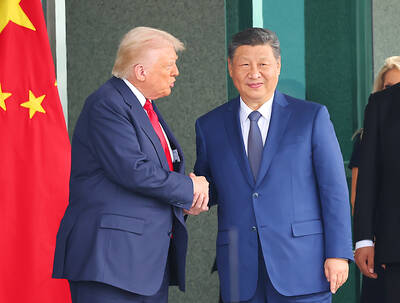Fujifilm Electronic Materials Taiwan Co (台灣富士電子材料) plans to invest NT$3.4 billion (US$110.4 million) in Taiwan to expand its chemical materials capacity used in advanced semiconductor technologies, it said yesterday.
The expansion is to meet growing demand for its chemicals, which are used in next-generation 2-nanometer technology, it said.
The three-year investment would double its local capacity for producing chemical-mechanical polishing (CMP) slurry, primarily by building a new factory in Hsinchu County’s Hukou Township (湖口) and expanding production in a plant at the Southern Taiwan Science Park (南部科學園區) in Tainan, the company said.

Photo: AFP
Fujifilm said it expects the new Hsinchu factory to start operations in early 2026 to produce CMP slurry and other semiconductor chemicals used in the manufacturing of 2-nanometer chips. The Tainan site produces semiconductor materials used in advanced technologies such as 3-nanometer chips.
The new lines in Tainan would start production in the first half of next year, it said.
The company operates three manufacturing facilities in Taiwan — two in Hsinchu County and one in Tainan.
Taiwan is one of the company’s major CMP manufacturing sites, in addition to those in Japan, South Korea and the US.
With a variety of special chemicals and materials on offer, Fujifilm Electronic Materials Taiwan has a long customer list, including Taiwan Semiconductor Manufacturing Co (TSMC, 台積電), United Microelectronics Corp (聯電) and ASE Technology Holding Co (日月光投控).
TSMC said it is to start volume production of 2-nanometer chips by 2025 at its Hsinchu or Taichung fabs.
TSMC also said its 2-nanometer technology would be the most advanced when it becomes available in 2025.
“In order to further the growth of the company in the future, today we’d like to present our future biz plan for all of you. I believe we will continue to work with Taiwan’s [semiconductor] industry, Taiwan’s community and Taiwan people for further growth,” Fujifilm Electronic Materials Taiwan chairman Kenichi Tanaka told a news conference in Taipei.
The company’s latest investment is part of a broader growth target set by its parent company, Fujifilm Electronic Materials Co. The Japanese company aims to nearly triple its revenue from ¥180 billion (US$1.34 billion) to ¥500 billion by the 2030 fiscal year.
The company expects the new investment to create 50 to 60 new jobs including in research and development.
That would bring the company’s overall headcount to about 300 people, it said.
Fujifilm Electronic Materials Taiwan also makes CMP cleaner, photoresist, polyimides and other chemicals used in the semiconductor manufacturing process.
Its customers are digesting excessive inventory at a slower pace than it expected, but it is optimistic about the semiconductor industry’s long-term growth, driven by 5G, Internet of Things and other devices, the company said.
As it takes three to five years to develop next-generation products, it has to invest ahead, it said.

RUN IT BACK: A succesful first project working with hyperscalers to design chips encouraged MediaTek to start a second project, aiming to hit stride in 2028 MediaTek Inc (聯發科), the world’s biggest smartphone chip supplier, yesterday said it is engaging a second hyperscaler to help design artificial intelligence (AI) accelerators used in data centers following a similar project expected to generate revenue streams soon. The first AI accelerator project is to bring in US$1 billion revenue next year and several billion US dollars more in 2027, MediaTek chief executive officer Rick Tsai (蔡力行) told a virtual investor conference yesterday. The second AI accelerator project is expected to contribute to revenue beginning in 2028, Tsai said. MediaTek yesterday raised its revenue forecast for the global AI accelerator used

TEMPORARY TRUCE: China has made concessions to ease rare earth trade controls, among others, while Washington holds fire on a 100% tariff on all Chinese goods China is effectively suspending implementation of additional export controls on rare earth metals and terminating investigations targeting US companies in the semiconductor supply chain, the White House announced. The White House on Saturday issued a fact sheet outlining some details of the trade pact agreed to earlier in the week by US President Donald Trump and Chinese President Xi Jinping (習近平) that aimed to ease tensions between the world’s two largest economies. Under the deal, China is to issue general licenses valid for exports of rare earths, gallium, germanium, antimony and graphite “for the benefit of US end users and their suppliers

Dutch chipmaker Nexperia BV’s China unit yesterday said that it had established sufficient inventories of finished goods and works-in-progress, and that its supply chain remained secure and stable after its parent halted wafer supplies. The Dutch company suspended supplies of wafers to its Chinese assembly plant a week ago, calling it “a direct consequence of the local management’s recent failure to comply with the agreed contractual payment terms,” Reuters reported on Friday last week. Its China unit called Nexperia’s suspension “unilateral” and “extremely irresponsible,” adding that the Dutch parent’s claim about contractual payment was “misleading and highly deceptive,” according to a statement

The Chinese government has issued guidance requiring new data center projects that have received any state funds to only use domestically made artificial intelligence (AI) chips, two sources familiar with the matter told Reuters. In recent weeks, Chinese regulatory authorities have ordered such data centers that are less than 30 percent complete to remove all installed foreign chips, or cancel plans to purchase them, while projects in a more advanced stage would be decided on a case-by-case basis, the sources said. The move could represent one of China’s most aggressive steps yet to eliminate foreign technology from its critical infrastructure amid a